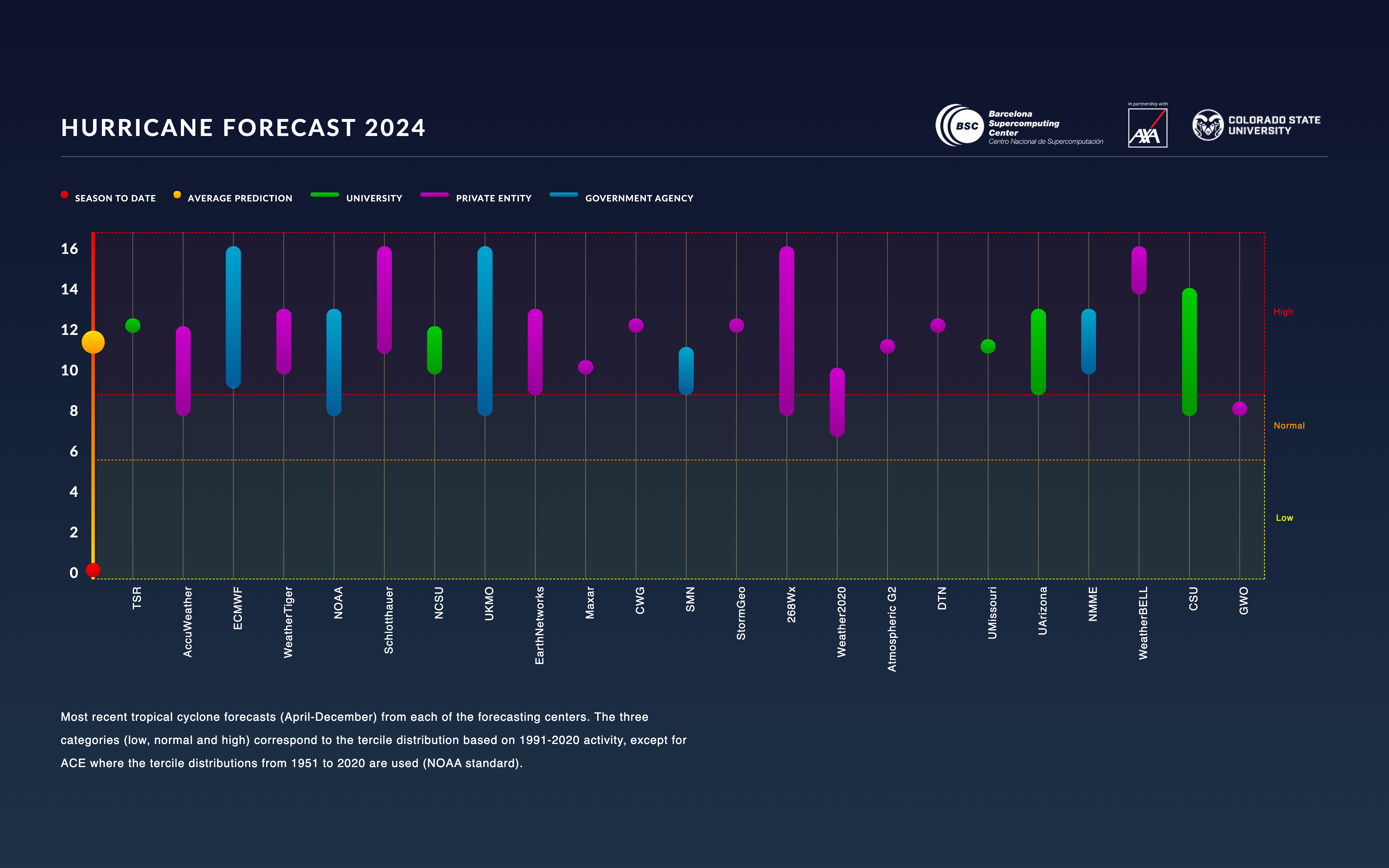Presque tous les prévisionnistes réputés annoncent une saison des ouragans 2024 extrêmement active. Et si votre organisation n'est pas préparée, cela pourrait entraîner des perturbations, des coûts, voire des dommages pour votre personnel et vos biens.
Personne n'aime se préparer à l'excès et perdre du temps, de l'argent ou des ressources sur une prévision à long terme. Mais quelles que soient les prévisions saisonnières, il suffit qu'une tempête survienne au mauvais moment et au mauvais endroit pour que les activités soient interrompues et que votre résultat net en pâtisse.
Accord unanime sur une saison active
Les chercheurs de la Colorado State University (CSU) suivent les prévisions crédibles des agences gouvernementales, des entités privées et des universités concernant la saison des ouragans. Tous prévoient un nombre de tempêtes tropicales et d'ouragans supérieur à la normale dans le bassin atlantique tropical, et nombre d'entre eux prévoient une activité bien supérieure à la normale.

La NOAA a publié ses prévisions annuelles d'avant-saison la semaine dernière, prévoyant 85 % de chances pour une saison supérieure à la normale. Les experts du CSU prévoient une saison "extrêmement active", avec jusqu'à 23 tempêtes nommées et 11 ouragans. C'est presque le double de la moyenne sur 30 ans, qui est de 12 tempêtes nommées et d'un peu plus de six ouragans.
Tous les indicateurs crédibles des tendances saisonnières dans les tropiques indiquent une activité bien supérieure à la normale cette année. La transition rapide prévue d'El Niño à La Niña est en tête de liste, ce qui peut produire un environnement en altitude plus favorable aux ouragans dans les Caraïbes et l'Atlantique occidental. Des eaux océaniques d'une chaleur record et un schéma de mousson favorable sur l'Afrique de l'Ouest préparent également la principale région de développement (MDR) de l'océan Atlantique, où naissent la plupart des ouragans.
Comprendre le coût des tempêtes
Depuis 40 ans, les ouragans sont les catastrophes naturelles les plus meurtrières et les plus coûteuses aux États-Unis. Il est difficile de prévoir l'impact financier d'un ouragan, mais il est clair que les coûts ne diminuent pas.
Le changement climatique entraîne une intensification plus rapide des tempêtes, ce qui amplifie leurs effets et laisse moins de temps pour se préparer. L'augmentation des populations côtières expose davantage de personnes et d'entreprises à des risques, ce qui entraîne des conséquences indirectes et une hausse des coûts de réparation.
Prendre la bonne décision au mauvais moment peut s'avérer une erreur coûteuse. Il ne suffit pas d'acheter les bonnes données météorologiques. Vous devez savoir comment et quand les utiliser. Et nous avons une fiche d'aide pour cela. Les informations contenues dans notre guide sur les ouragans à l'intention des décideurs vous seront utiles lorsque vous commencerez à voir des projections d'ouragans ou de tempêtes tropicales susceptibles d'affecter votre entreprise ou vos actifs.
Pour éviter les dépenses imprévues, il est important de disposer d'un plan d'intervention cohérent, adapté aux conséquences potentielles d'une tempête sur vos finances. Ce plan doit être envisagé chaque année pour tous les sites exposés, quelles que soient les prévisions d'avant-saison.
Se préparer aux impacts, pas seulement aux prévisions
Un nombre élevé de tempêtes tropicales ou d'ouragans ne signifie pas nécessairement que l'année sera mauvaise pour les atterrissages aux États-Unis. L'impact d'une tempête dépend de sa trajectoire, de sa force et de son mouvement, qui sont difficiles à prévoir des mois à l'avance, et encore plus cinq jours à l'avance.
Le lien entre le nombre d'ouragans et ceux qui touchent les terres est souvent faible et imprévisible. Par exemple, il y a eu des saisons où l'activité des ouragans était supérieure à la normale, mais sans impact sur les États-Unis. À l'inverse, des ouragans majeurs ont frappé à plusieurs reprises au cours d'années relativement calmes.
Cependant, des progrès ont été réalisés dans l'évaluation de la vulnérabilité d'un littoral particulier au cours d'une année donnée. Cette évaluation repose en grande partie sur les variations statistiques des prévisions saisonnières pour l'ensemble du bassin atlantique. Par exemple, les chercheurs du CSU affirment qu'il y a 62 % de chances qu'un ouragan majeur touche terre aux États-Unis, ce qui est nettement plus élevé que la normale (43 %).
Les responsables des situations d'urgence et les météorologues utilisent souvent l'expression "il suffit d'un seul" pour dissuader le public de réagir au battage médiatique d'une prévision saisonnière. Il en va de même pour l'état d'esprit de votre équipe. Votre énergie émotionnelle est mieux employée à évaluer les risques pour vos biens et à vous préparer aux conséquences d'une tempête qu'à vous inquiéter des perspectives à long terme. Voici pourquoi.
Éviter les informations trompeuses
Chaque ouragan est unique et il est important de rester préparé année après année pour éviter de prendre des décisions coûteuses sur la base d'informations trompeuses. Au lieu de se concentrer sur les prévisions à six mois, il est plus avantageux de se concentrer sur les vulnérabilités spécifiques aux impacts potentiels.
Les ouragans sont complexes, et la planification de leur impact, ainsi que l'atténuation de leurs effets et la réponse à y apporter, le sont encore plus. Investir dans des outils de surveillance météorologique, des analyses historiques et des prévisions à court terme peut aider à suivre avec précision la progression d'une tempête et à prendre des décisions éclairées. Demander l'avis d'un expert peut vous permettre de prendre de meilleures décisions.
